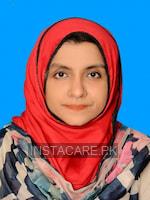Pediatric Cancers - Symptoms, Risk factors and Treatment
Last Updated On Monday, January 5, 2026
Pediatric Cancers in Urdu
کینسر ایک بیماری ہے جس میں جسم میں غیر معمولی خلیات کی بے قابو تقسیم ہوتی ہے۔ یہ جسم کے دوسرے حصوں میں پھیل سکتا ہے اور دنیا میں موت کی دوسری سب سے عام وجہ ہے۔
لفظ کینسر ایک وسیع اصطلاح ہے، اور مختلف عوامل پر منحصر ہے، جیسے سیل کی قسم جس سے یہ نکلتا ہے یا عضو۔ مختلف عمروں میں کینسر کی مختلف اقسام زیادہ عام ہیں۔
بچوں میں کینسر صحت کی دیکھ بھال کی ایک بڑی تشویش ہے، اور مختلف عوامل جیسے ماحولیاتی نمائش، خاندانی تاریخ وغیرہ، کینسر کی مختلف اقسام میں کردار ادا کر سکتے ہیں۔ اگرچہ ہر بیماری کینسر نہیں ہو سکتی، لیکن بچوں میں علامات کا جلد پتہ لگانا اور کینسر کی تشخیص ایک ہی وقت میں علاج اور بقا کا تعین کرنے میں بنیادی اہمیت کا کردار ادا کرتی ہے۔ علاج کا مقصد علامتی امداد، کیموتھراپی، اور ریڈیو تھراپی فراہم کرنا ہو سکتا ہے۔
Pediatric Cancers in English
Cancer is a disease in which there is an uncontrolled division of abnormal cells in the body. It can spread to other parts of the body and accounts for the second most common cause of death in the world.
The word cancer is a broad term, and it has several types depending upon different factors, such as the cell type from which it originates or the organ. Different types of cancer are more common in different ages.
In children ( aged 0-14), cancers of the following organs and tissues are most prevalent:
- Blood
- Brain and CNs
- Kidney
- Lymphocytes (Immune cells)
- Soft tissues
- Eyes
- Bones
In this article, we will briefly discuss the cancers originating in these organs.
Leukemia (Blood cancer):
Leukemias are the most common cancers of childhood. This type of cancer affects the bone marrow- the tissue inside your bones responsible for producing blood cells, causing the production of abnormal blood cells. In children, acute types of leukemia are more common such as acute lymphoblastic leukemia (ALL) and acute myeloblastic leukemia (AML). Acute leukemias can spread fast and require an urgent diagnosis. With early diagnosis and treatment, such as chemotherapy and radiotherapy, leukemias can be cured.
The symptoms of leukemia include:
- Bone pain
- Fatigue
- Bruises on skin
- Increased infections
- Weight loss
- Fever
Brain and central nervous system tumors:
Brain and CNS tumors are the second most common cancer in children after blood cancers and represent commonly as tumors- a mass of abnormal cells that interferes with the normal functioning of the organ. These cancers can affect the brain and the spinal cord. There are different types of brain and CNS tumors, such as medulloblastoma, glioma, astrocytoma, oligodendroglioma, and ependymoma. They are named according to the cell type from which they originate. There could be many symptoms of brain and CNS tumors, and these symptoms may also resemble that of other non-cancerous diseases. The common symptoms in these tumors are:
- Headache
- Seizures
- Nausea
- Vomiting
- Dizziness
- Drowsiness
- Vision problems
- Memory problems
- Difficulty in walking
Neuroblastoma:
Neuroblastoma is also a cancer of the nervous system, but it originates from immature nerve cells. Most commonly, it arises in the adrenal glands but can occur anywhere else in the body. The symptoms vary according to the location of the tumor.
The symptoms of neuroblastoma are:
General symptoms:
- Weight loss
- Fatigue
- Fever
- Bone pain
If in the adrenals:
- Abdominal pain
- Abdominal swelling
If in the chest:
- Wheezing
- Chest pain
- Difficulty in breathing
- Horner syndrome symptoms- small pupils, drooping eyelids, etc.
Wilms tumor (kidney tumor):
Wilms tumor is a tumor of the kidney, also known as nephroblastoma. It can affect one or both kidneys. It is more common in children less than 5 years old. The common symptoms of Wilms tumor are:
- Abdominal mass or swelling
- Abdominal pain
- Weight loss
- Fever
- Nausea
- Vomiting
Lymphoma (cancer of lymphocytes):
Lymphoma is the cancer of lymphocytes, which are the infection-fighting cells of the immune system. It mainly affects the lymph nodes, thymus, spleen, and bone marrow but can spread quickly to other organs too. There are two types of lymphomas, namely Hodgkin’s lymphoma-that may not affect every lymph node and skip some lymph nodes, and Non-Hodgkin's lymphoma- which spreads from one lymph node to the adjacent one. Both types of lymphoma are seen in children.
The symptoms of lymphoma are:
- Fever
- Chills
- Weight loss
- Tiredness or fatigue
- Shortness of breath
- Swelling of lymph nodes
Rhabdomyosarcoma (soft tissue tumor):
This type of cancer can affect nearly any part of the body, but it more commonly affects the skeletal muscles. The signs and symptoms of rhabdomyosarcoma differ according to the organ or part of the body it affects.
Retinoblastoma (cancer of the eye):
Retinoblastoma begins in the retina- the layer at the back of the eye that helps in converting signals from light to the neural signals that the brain can read.
Bone cancers (Osteosarcoma and Ewing’s sarcoma):
Both osteosarcoma and Ewing's sarcoma are cancers of the bone. Osteosarcoma is usually present in fast-growing bones such as the bones of the arm and leg. Ewing sarcoma is more common in teenagers and older adults and can affect the hip bone, ribs, shoulder blades, chest bone, and leg bones. Bone cancers typically present with bone pain and swelling.
Conclusion:
Cancers in children are a major healthcare concern, and different factors like environmental exposure, family history, etc., may play a role in different types of cancers. While not every disease can be cancer, early detection of symptoms and diagnosis of cancer in children plays a role of paramount importance in determining the treatment and survival at the same time. Treatment may be aimed at providing symptomatic relief, chemotherapy, and radiotherapy.









